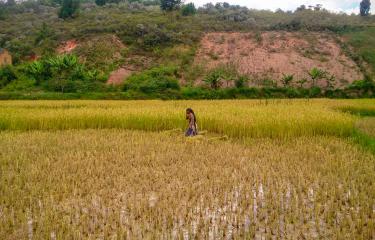An extensive genomic study of pygmy hunter-gatherer populations and agricultural village communities, conducted in Central Africa by scientists from the Institut Pasteur and the French National Center for Scientific Research (CNRS), in collaboration with the French National Museum of Natural History (MNHN), the University of Montreal and the University of Lyon 2, challenges the established understanding of the role played by agriculture in African Neolithic history. It would appear that agriculture was not directly responsible for the demographic success of populations that adopted it or for the high level of genetic mixing between agricultural and pygmy populations. The results of this research are published in Nature Communications.
Press release
Paris, February 5, 2014

The emergence of agriculture heralded an unprecedented technological, cultural and environmental revolution for the human race. It was previously thought that on every continent the biggest demographic explosions ever seen in humans were triggered by the abundance of resources generated by agriculture, coupled with domestication and the adoption of a sedentary lifestyle. Recent studies, however, had already begun to cast doubt on this theory with regard to the African continent. Scientists Etienne Patin and Lluis Quintana-Murci (Human Evolutionary Genetics Unit, Institut Pasteur/CNRS) now reveal results that corroborate the conclusions of these studies and provide additional information, in the publication of the broadest study ever undertaken in this field.
The scientists' work was carried out in close collaboration with teams from the French National Museum of Natural History, the University of Lyon 2 and the University of Montreal. It is based on an in-depth analysis of the entire genome of over 300 individuals in Central Africa, both from pygmy populations, which are the largest group of hunter-gatherers still in existence today, and from sedentary farming populations.
The development of agriculture in sub-Saharan Africa dates back some 5,000 years. This genomic study has established that the main demographic explosion that occurred in the ancestors of farming communities predates this period. Although the scientists do not rule out the possibility that the first farming communities also started to expand 5,000 years ago, they think it more likely that the hunter-gatherers who were the ancestors of modern-day farmers experienced demographic growth between 10,000 and 7,000 years ago on a scale that forced them into a new lifestyle, in which they turned to agriculture for sustenance. Conversely, pygmy hunter-gatherer populations experienced a demographic bottleneck between 30,000 and 10,000 years ago. This suggests that, long before the advent of agriculture, these populations were evolving in very different ways, independently of any agricultural activity.
The research also reveals other unexpected results. It would appear that, despite the fact that these populations have lived side by side and maintained regular contact for 5,000 years, which is clear from studies of oral traditions and languages as well as the genetic diversity of the shared pathogenic agents, genetic mixing of pygmy and farming populations started a mere 1,000 years ago. This late mixing, which contradicts the conventionally accepted demographic pattern, and stands as evidence of the particular socio-economic structure of these populations, was subsequently extremely intense: the genomes of modern pygmy populations reflect a mix of up to 50% with farming populations. Mixing occurred primarily in a single direction: men from farming populations frequented women from pygmy populations, but the reverse happened only rarely.
The scientists are now trying to understand the genetic mechanisms behind the demographic growth or decline seen in these two populations. They believe that these genetic mechanisms could be linked to the various environmental constraints to which these ethnic populations have been exposed in the past, including those caused by pathogenic agents.
Human genetic data reveal contrasting demographic patterns between sedentary and nomadic populations that predate the emergence of farming. Aimé C, et al., Mol Biol Evol. 2013 Dec;30(12):2629-44.
doi: 10.1093/molbev/mst156. Epub Sept 24, 2013.
Image : Paul Verdu
SOURCE
The impact of agricultural emergence on the genetic history of African rainforest hunter-gatherers and agriculturalists,
E. Patin & all, Nature Communications, February 4, 2014.
* Other study mentionned in the press release : Human genetic data reveal contrasting demographic patterns between sedentary and nomadic populations that predate the emergence of farming. Aimé C & coll., Mol Biol Evol. 2013 Dec;30(12):2629-44. Epub 2013 Sep 24. doi: 10.1093/molbev/mst156
CONTACT
Insitut Pasteur press office
Marion Doucet – marion.doucet@pasteur.fr - +33 (0)1 45 68 89 28
Nadine Peyrolo - nadine.peyrolo@pasteur.fr - +33 (0)1 45 68 81 47









